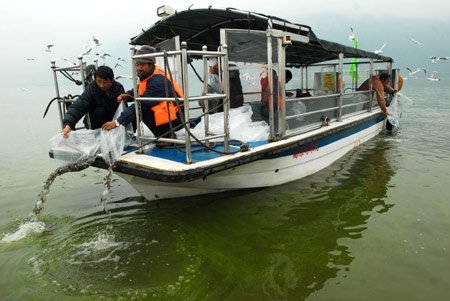Photos
Growth threatens water supply
Updated: 2010-12-09 15:44
By Wang Qian (China Daily)
|
 |
| Fishermen release jinxianba, a species of ray-finned fish, into Dianchi Lake in Kunming, capital of Yunnan province, on Wednesday. Jinxianba, which curb the growth of blue algae, could help improve the water quality of the lake. [Photo/Agencies] |
BEIJING - The expected rapid urbanization during the coming 12th Five-Year Plan (2011-2015) will threaten the security of China's water resources, authorities said.
Pollution control and prevention guidelines on eight major rivers and lakes across the country for the next five years were jointly released on Tuesday by the ministries of Environmental Protection, Water Resources, Agriculture, Housing and Urban-Rural Development, Industry and Information Technology, and the National Development and Reform Commission.
All the plans mentioned that rapid urbanization and fast economic development are posing great challenges to water protection in the eight rivers and lakes, including Haihe River near Beijing and Huaihe River, which marks the boundary between China's north and south.
The volume of pollutants in these waterways during the next five years will increase by 35 to 40 percent due to the industrialization and urbanization in the Haihe River area, according to the plan for that water system.
The plan for the Yellow River said rapid economic development along the river area would create a water shortage of about 14 billion cubic meters by 2030.
According to the plan for Liaohe River, which flows through Liaoning province, breakneck GDP growth will increase the pressure on the river system.
Water pollution has long been a problem for authorities.
A four-year study released by the China Geological Survey in November showed that only 24 percent of the underground water in the North China Plain is safe for direct drinking as excessive heavy metal and chemical fertilizers were found in most water resources.
Ammonia and nitrogen tested in the eight rivers were highlighted on a black list of water pollutants, the plans said.
About 30 percent of the monitored spots along the Yangtze River were found to have excessive ammonia and nitrogen, mainly caused by domestic waste and excessive use of fertilizers.
In some parts of Huaihe River, the amounts of ammonia and nitrogen were more than 10 times the national standard for surface water, posing dangers to water safety. Industrial pollution and domestic waste accounted for 75 percent of these pollutants.
Li Shanzheng, professor with the Beijing Hydraulic Research Institute, told China Daily on Wednesday that water shortages in China were severe.
"Saving water and finding ways to recycle it will help to alleviate the pressure the country is facing," Li said, adding that the nation needs more sewage treatment plants.
E-paper

Ear We Go
China and the world set to embrace the merciful, peaceful year of rabbit
Preview of the coming issue
Carrefour finds the going tough in China
Maid to Order
Specials

Mysteries written in blood
Historical records and Caucasian features of locals suggest link with Roman Empire.

Winning Charm
Coastal Yantai banks on little things that matter to grow

New rules to hit property market
The State Council launched a new round of measures to rein in property prices.




